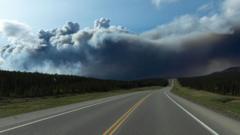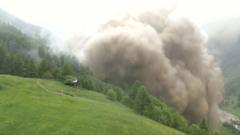The mountain, Japan's highest, has recorded the absence of snow later into the autumn than any other year since records began, raising alarms about ongoing temperature trends.
**Mount Fuji Experiences Record Late Snow Loss Amid Unprecedented Warmth**

**Mount Fuji Experiences Record Late Snow Loss Amid Unprecedented Warmth**
Mount Fuji remains snowless later in the year than ever before, sparking concern over climate impacts.
Mount Fuji is experiencing an unprecedented delay in its seasonal snowfall, marking the latest date ever recorded for snow-free conditions since monitoring began 130 years ago. Typically, Japan's iconic mountain sees its first dusting of snow by early October, but this year, warmer-than-average temperatures have resulted in no snowfall thus far. According to reports from AFP, the first snow on Mount Fuji was recorded on 5 October in previous years, while 2023 has set a new record.
Japan faced an extreme summer this year, with temperatures from June to August averaging 1.76°C (35.1°F) above the norm. Even as September rolled in, warmth prevailed, pushed by a sub-tropical jet stream that promoted a flow of hot air over the region. The country recorded nearly 1,500 locations hitting what is classified as "extremely hot" days, defined as temperatures reaching or exceeding 35°C (95°F).
While October's heat has slightly subsided, it still remains above average as the month progresses. The almost snowless November marks the longest annual wait for a snowcap on Mount Fuji since the beginning of data collection in 1894. Previously, the last snow had been seen on 26 October, a date that occurred twice, in 1955 and 2016, as noted by forecaster Yutaka Katsuta from the Kofu Local Meteorological Office.
Mount Fuji stands at 3,776 meters (12,460 feet) southwest of Tokyo and is a dormant volcano with its last eruption occurring over 300 years ago. The majestic peak is a beloved symbol in Japanese art and culture, often depicted in woodblock prints. Last year alone, over 220,000 visitors climbed to its peak between July and September, highlighting the mountain's enduring popularity despite the recent worrying climate trends.
Japan faced an extreme summer this year, with temperatures from June to August averaging 1.76°C (35.1°F) above the norm. Even as September rolled in, warmth prevailed, pushed by a sub-tropical jet stream that promoted a flow of hot air over the region. The country recorded nearly 1,500 locations hitting what is classified as "extremely hot" days, defined as temperatures reaching or exceeding 35°C (95°F).
While October's heat has slightly subsided, it still remains above average as the month progresses. The almost snowless November marks the longest annual wait for a snowcap on Mount Fuji since the beginning of data collection in 1894. Previously, the last snow had been seen on 26 October, a date that occurred twice, in 1955 and 2016, as noted by forecaster Yutaka Katsuta from the Kofu Local Meteorological Office.
Mount Fuji stands at 3,776 meters (12,460 feet) southwest of Tokyo and is a dormant volcano with its last eruption occurring over 300 years ago. The majestic peak is a beloved symbol in Japanese art and culture, often depicted in woodblock prints. Last year alone, over 220,000 visitors climbed to its peak between July and September, highlighting the mountain's enduring popularity despite the recent worrying climate trends.






















